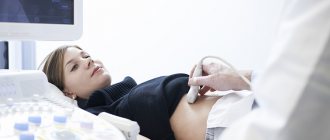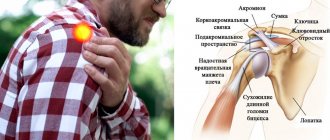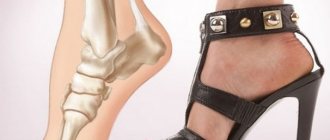Video
Pain under the shoulder blade. Question answer.
Topic: Questions and Answers
Pain under the shoulder blade
Topic: Encyclopedia of diseases
Title
- Pain under the left shoulder blade
- Pain under the right shoulder blade
- Diagnostics
- Treatment methods
Pain under the shoulder blade is a fairly common complaint among patients and often presents difficulties both for diagnosis and treatment. The pain can be localized both under the left and under the right shoulder blade.
The main causes of pain under the right shoulder blade
Let's look at the main causes of back pain in the area of the right shoulder blade. Do not forget, the presence of this symptom may indicate a serious surgical disease that requires emergency medical attention.
Gallbladder diseases
Back pain in the area of the right shoulder blade is a common symptom in acute or chronic cholecystitis (inflammation of the gallbladder). Thus, local pain in the area of the inner corner of the right scapula, which increases with pressure, is called Kharitonov’s symptom - this is one of the specific signs of acute inflammation of the gallbladder. Similar points are present on the inside of the scapula in its lower part, and in the area of the transition of the scapula to the collarbone, on the right.
If there are stones in the gall bladder, which interfere with the flow of bile, intense abdominal pain occurs, radiating to the right shoulder blade, right shoulder, and interscapular space. The nature of the pain in the back is aching, pulling, while the pain in the abdomen is sharp, cutting, paroxysmal. If you have such symptoms, you should immediately consult a doctor for examination and to exclude acute surgical pathology.
Subphrenic abscess
Subphrenic abscess is an acute surgical disease, a complication of acute cholecystitis, appendicitis, and other surgical pathologies of the abdominal organs, in which pus accumulates. Most often, an abscess forms on the right, above the liver, and is accompanied by pain in the abdomen, lower back, and the right side of the back under the shoulder blade. Subphrenic abscess can also occur after surgery on the abdominal organs as a complication.
Bronchopulmonary diseases
Diseases of the bronchi and lungs, such as pleurisy, pneumonia, bronchopulmonary cancer, are almost always accompanied by pain in the chest and back. Due to the large number of pain receptors in the pleural cavity, pain can be sharp, acute, and intensify with breathing, coughing, and sneezing. The localization of pain is different and depends on the location of the focus in the lungs or pleural cavity.
Shpidonov Gennady Stanislavovich
Neurologist
Rostov State Medical University (neurology)
10 years of experience
Kidney diseases
Kidney diseases such as acute pyelonephritis, renal colic, kidney stones, abscess, cancer may be accompanied by pain in the shoulder blades. If the right kidney is affected, the patient will experience back pain under the right shoulder blade. If left, then left. The nature of the pain is sharp, pulling, cutting, paroxysmal, pain occurs simultaneously with pain in the lower back and hypochondrial areas in front. Fever, pain when urinating, nausea and vomiting are possible.
Diseases of the musculoskeletal system
Diseases of the musculoskeletal system are the main cause of pain in the shoulder blades. Among them are diseases such as spinal osteochondrosis, intervertebral disc herniation, scoliosis, spondyloarthritis and spondyloarthrosis. The source of pain can be a pathological muscle spasm that occurs due to instability of the spinal column, overstrain of the back muscles trying to compensate for the load on the sore back. It is characterized by constant aching pain that subsides with rest. With hernias and protrusions, pain can be caused by pinching of the spinal cord roots. The pain is sharp, acute, radiating to the shoulder blades, upper limbs, chest, and intensifies with physical activity and heavy lifting.
The immediate cause of pain behind the right or left shoulder blade from behind from the back may be associated with the shoulder blade itself, as happens with glenohumeral periarthritis. The disease occurs with degenerative-dystrophic damage to the shoulder joint, and is accompanied by inflammation of nearby soft tissues - muscles, ligaments and tendons. At the beginning of the disease, the pain is episodic in nature and occurs during physical activity, maximum elevation or abduction of the arm, and when throwing with the arm. Then they take on the character of constant pain, and bother you even at rest, sharply intensifying when you move your hand.
Muscle strain and inflammation
Muscle strain and inflammation (myositis) are common causes of pain in the shoulder blade, right or left. Pain occurs as a result of excessive physical activity, when playing sports, or lifting weights. As a result, microscopic ruptures of muscle fibers occur in the affected muscles, and minor hemorrhages are possible. Swelling and inflammation occurs at the site of injury. The pain is sharp and intensifies with movement and physical activity.
Myositis or muscle inflammation can be an independent disease that occurs due to hypothermia, draft, or intoxication due to acute respiratory viral infections. Less commonly, the disease is a consequence of autoimmune or rheumatic diseases. The pain is aching, prolonged, and intensifies with movement. The scapula area is affected quite often due to the presence of developed muscles.
Shpidonov Gennady Stanislavovich
Neurologist
Rostov State Medical University (neurology)
10 years of experience
Intercostal neuralgia
Neuralgia is attacks of sharp acute pain along the nerves, arising due to hypothermia, inflammation or irritation of the spinal cord roots in diseases of the spine. With intercostal neuralgia, pain spreads along the intercostal spaces and can be localized both under the right and left shoulder blades, behind the back, or on the sides and front of the chest. The pain is sharp, sharp, and worsens with breathing, movement, coughing or sneezing. The patient has to spare himself in attempts to relieve the pain, limiting the depth of breathing, trying not to cough or sneeze. In some cases, the pain can be so severe that it is necessary to resort to novocaine blockade of the intercostal nerves.
Diseases or injuries of the scapula
Diseases of the scapula that lead to pain include bruises, fractures and cracks of the scapula, benign and malignant tumors (sarcomas, osteochondromas, osteomas, etc.). Injuries occur due to direct physical impact (impact, falling on your back, traffic accident). A characteristic sign is pronounced swelling of the soft tissues in the area of the scapula, sharp acute pain, intensifying when moving the hand, crunching (in case of fractures, occurs due to friction of moving bone fragments).
With tumors, pain can be of a different nature, from aching, arching pain to severe pain. The pain is constant and not relieved by rest. Visually or by touch, a foreign dense and immovable formation in the area of the scapula associated with it can be determined.
Diagnostics
Pain under the right shoulder blade occurs in diseases of various organs and systems, which requires the involvement of several specialists and a careful differential diagnosis. During a physical examination, the doctor will look for skin manifestations, signs of injury, or spinal curvature that may cause tenderness in the subscapular area. The most informative instrumental methods for diagnosis are:
- CT scan of the spine.
In orthopedics and traumatology, standard radiography is also used, but computed tomography provides clearer and more detailed visualization of bone formations. In the photographs, the specialist determines postural disorders, damage to the vertebrae, and signs of ankylosing spondylitis. Neurological complications of osteochondrosis can be detected by MRI of the spine. - Ultrasound of the abdominal cavity.
Given the high prevalence of hepatobiliary disorders, standard diagnosis includes ultrasound examination of this area. On ultrasound, biliary stones, thickening of the gallbladder wall, and inflammatory changes in the liver are clearly visible. To assess the contractile function of the bladder, a test is done with a choleretic breakfast. - ERCP.
Invasive endoscopic examination of the biliary tract is the main method for diagnosing cholelithiasis, cholecystitis, cholangitis and functional disorders. The study is carried out for contrast visualization of the ductal system, finding filling defects and inflammation. - X-ray of the OGK.
Diagnosis of pulmonary diseases is impossible without a standard x-ray in 2 projections. The doctor pays attention to focal infiltrates in the lungs, effusion in the pleural cavity, and symptoms of pneumothorax. It is extremely rare that x-rays confirm dextrocardia - then the pain under the right shoulder blade may be of cardiac origin. - Additional invasive methods
. To detect problems with bile secretion, duodenal intubation is prescribed. For difficult to diagnose pulmonary pathologies, bronchoscopy, pleural puncture, and transthoracic biopsy are recommended. Gastrointestinal diseases with an atypical course require diagnostic laparoscopy.
Instrumental studies are complemented by laboratory methods. In the hemogram, special attention is paid to leukocytosis and increased ESR as nonspecific signs of infection. A biochemical blood test is informative for verifying the syndrome of cytolysis and cholestasis in pathological processes in the liver and gall bladder. An increase in acute phase parameters confirms the presence of active inflammation.
Detection of kidney damage is based on the results of a clinical urine test, a study of concentration function according to Zimnitsky, and a study of cellular composition according to Nechiporenko. If necessary, the diagnostic complex is supplemented with a bacteriological method - culture of sputum, feces, urine or other biological material is carried out on nutrient media.
Physical therapy for back pain
Types of pain under the shoulder blade on the right
Pain varies in severity and nature. Depending on the characteristics of the pain syndrome, it can be assumed what the underlying cause is. Thus, with intercostal neuralgia, the pain is almost always acute, intensifies with movement and coughing, turning into sharp shooting pains. Myositis is characterized by aching pain that can intensify with movement. Knowledge of the characteristics of pain syndrome in a particular pathology simplifies diagnosis.
Shpidonov Gennady Stanislavovich
Neurologist
Rostov State Medical University (neurology)
10 years of experience
Aching pain in the right shoulder blade
Aching pain in the area of the shoulder blades is characteristic of diseases of the musculoskeletal system, osteochondrosis, hernias and protrusions of intervertebral discs, myositis, and glenohumeral periarthritis in the initial stage. Similar pain can occur with diseases of the abdominal and thoracic organs, with neurological pathologies and pathologies of the spinal cord.
Acute pain under the shoulder blade on the right
Acute pain under the scapula on the right or left is a symptom characteristic of injuries, fractures, muscle strains, and tumors of the scapula. The cause of acute pain may be a hernia or protrusion of the intervertebral disc with radicular syndrome.
Sharp pain in the area of the right shoulder blade
Sharp pain in the area of the right shoulder blade is possible with intercostal neuralgia, diseases of the lungs, bronchi and pleura. Similar symptoms are observed with advanced glenohumeral periarthritis, severe myositis, and injuries.
Stitching pain behind the right shoulder blade
Stitching pain behind the right or left shoulder blade can be a symptom of diseases of the lungs and pleura (with pleurisy), myositis. Volatile stabbing pains are characteristic of radicular syndrome, when pain occurs due to pinching of the spinal cord roots, intercostal neuralgia.
Nagging pain in the right side of the back under the shoulder blade
A nagging pain in the right side of the back under the scapula is a symptom characteristic of acute or chronic cholecystitis, pancreatitis, and cholelithiasis. Similar symptoms can occur with kidney pathologies. Nagging pain in the right shoulder blade with a feeling of heaviness in the right hypochondrium may be a sign of subdiaphragmatic abscess, cirrhosis of the liver, or urolithiasis
Shpidonov Gennady Stanislavovich
Neurologist
Rostov State Medical University (neurology)
10 years of experience
Constant pain on the right side under the shoulder blade
Constant pain on the right or left under the scapula is a possible sign of a benign or malignant tumor of the scapula. Constant pain can also occur with chronic diseases of the spine, such as spondyloarthritis, spondyloarthrosis, osteochondrosis or intervertebral disc herniation.
Burning pain on the right side of the shoulder blade
Burning pain in the scapula area is a characteristic sign of herpes zoster before the appearance of rashes, intercostal neuralgia, and neuritis of the intercostal nerves. This symptom can occur with diseases of the spinal cord, such as multiple sclerosis, spinal cord tumors. Infringement of the spinal cord roots by a hernia in the thoracic spine can also lead to burning pain in the scapula area.
III. Is it necessary to conduct additional research methods?
At the appointment, the doctor, after assessing your condition (clinical picture) and medical history, makes a conclusion about the need or lack thereof for additional research methods. In most cases, if the pain syndrome is benign, the diagnosis is made based on the patient’s clinical picture. If there are “red flags”, depending on the conditions that the doctor wants to exclude, additional research methods may be prescribed, such as a blood test for inflammatory markers, tumor markers, MRI, computed tomography, radiography, or referred for consultation to a specialized specialist.
How to relieve pain under the right shoulder blade
If pain in the scapula area is associated with diseases of the spine, muscles or injury, then painkillers should be taken as first aid. For this purpose, non-steroidal anti-inflammatory drugs or NSAIDs are most often used. They effectively fight pain of any origin, suppressing inflammatory reactions. However, uncontrolled and long-term use of NSAIDs increases the risk of side effects of this group of drugs, such as stomach ulcers, gastric bleeding or kidney failure. Therefore, without a doctor’s prescription, it is permissible to take analgesics for no more than 5 days, after which you must consult a doctor for diagnosis and treatment.
Local remedies in the form of distracting and analgesic ointments, gels and patches do not have such side effects, since this dosage form is limited to the area of application. They help especially well with myositis, muscle strain, attacks of neuralgia and other diseases with chronic pain syndrome. In diseases of the spine, pain can be relieved by rest, limiting physical activity and prohibiting heavy lifting.
It is strictly forbidden to use painkillers if you suspect acute cholecystitis, pancreatitis and other diseases of the abdominal organs that require emergency surgery. Taking painkillers in such patients can lead to temporary relief of symptoms and a false sense of improvement, which ultimately contributes to late presentation and serious condition of the patient due to extensive inflammation of the peritoneum or peritonitis.
If pain in the area of the shoulder blade on the right occurs against the background of severe abdominal pain, accompanied by fever, nausea, and vomiting, you must seek medical help as quickly as possible.
Shpidonov Gennady Stanislavovich
Neurologist
Rostov State Medical University (neurology)
10 years of experience
general information
There are 12 pairs of intercostal nerves in the human body. They originate from the roots of the thoracic spinal cord and cover the entire chest, adjacent to the peritoneum, muscles, skin and mammary glands. The individual fibers of each nerve are responsible for tissue sensitivity, motor function and regulation of the functioning of all structures. Accordingly, damage or inflammation in any area can radiate pain to a variety of parts of the body.
The sensations can imitate diseases of internal organs: myocardial infarction, angina pectoris, pancreatitis, gastritis, cholecystitis, etc. In some cases, only a doctor can accurately determine the nature of the pain after a full examination. That is why it is important to seek help promptly if chest pain occurs.
Make an appointment
Treatment of pain on the right side of the shoulder blade
Pain treatment must begin with diagnosis, since effective pain management is only possible if you know its cause. Symptomatic therapy based on the use of analgesics does not treat the cause of pain, but only temporarily alleviates the most severe symptom. After making an accurate diagnosis, it is possible to treat the underlying disease by influencing the factors that led to it.
This is also important because without knowing the cause of the pain, it is difficult to choose the right treatment. Thus, attempts to treat pain in the scapula on the right side with analgesics in acute cholecystitis can lead to complications in the form of gangrene of the gallbladder, its perforation and extensive peritonitis, with a high risk of death. Painkillers are strictly contraindicated for acute surgical diseases of the abdominal organs.
Complications
Complications of intercostal neuralgia occur quite rarely, however, in severe cases, without appropriate treatment, the patient may encounter the following problems:
- severe spasm of the respiratory muscles, limiting inhalation and exhalation;
- inability to get out of bed due to significant increase in pain;
- excessive pain syndrome that is not relieved by conventional analgesics and NSAIDs;
- heart rhythm disturbances due to muscle spasms and nerve pathology;
- decreased leg mobility.
In addition, complications can be caused by attempts to be treated outside the clinic. Abscesses and cellulitis after acupuncture, paralysis and decreased sensitivity after manual therapy are not a complete list of problems. That is why you should not treat intercostal neuralgia either independently or with the help of dubious specialists.
Diagnostic measures
Our specialists will make a more precise diagnosis after carrying out the necessary laboratory and instrumental diagnostics using the most modern equipment. When indicated, the following will be carried out:
- blood tests;
- urine test to evaluate kidney function;
- performing liver function tests;
- gastric endoscopy;
- Ultrasound for diagnosing somatic disorders, cardiac and vascular conditions;
- CT scan of the liver, pancreas;
- ECG of the heart;
- X-ray of the sternum.
Based on the fact that pain under the left shoulder blade from the back may not be a symptom of a single disease, a comprehensive examination by several specialists is not excluded. Our clinic offers patients one of the modern comprehensive types of examination - check-up, which includes many types of tests with the smallest set of diagnostic procedures. Timely contact with our specialists and a guaranteed correct diagnosis will help the patient undergo high-quality and successful treatment.
Post-medication procedures
After drug treatment and relief from pain in the area of the right shoulder blade, the patient is recommended to undergo a course of therapy aimed at restoring the immune system and strengthening the musculoskeletal system in the chest, neck and spine. These procedures help minimize relapse of the disease.
To start practicing therapeutic exercises, you need to make sure that the source of pain is completely eliminated, and the pain itself is reduced to a minimum. Any physical activity is carried out exclusively with the permission of a doctor and is carried out in the presence of a specialist.
Gymnastics that strengthens the shoulder blades
Advantages of the clinic
In the neurology department of the Energy of Health clinic, every patient receives the highest level of specialists and modern equipment for diagnosing and treating diseases. We take an integrated approach to therapy and use not only medications, but also physiotherapy, exercise therapy and massage.
Treatment is prescribed only after a thorough examination and is monitored by a specialist until the patients fully recover. Adequate prices, convenient location, private parking - we do everything for the convenience of our clients.
If intercostal neuralgia interferes with living, walking and moving, do not delay treatment. Sign up for the Health Energy clinic and get rid of pain.











